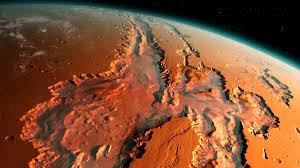|
|
|

MARS - THE REALITY OF HUMAN LIFEOR ILLUSION  | Simo Jelača | |
| |
detail from: KRK Art dizajn
MARS - THE REALITY OF HUMAN LIFEOR ILLUSION
Dr. SIMO JELAČA
Mars is the fourth planet in the solar system in terms of distance from the Sun, from which it is about 230 million kilometers away, and from Earth it is about 228 million kilometers away. It is the seventh largest in the solar system, twice the size of Earth. The diameter of Mars is about 6780 km. The surface gravity on Mars is only 27.5% of the ground gravity, which means that a man weighing 75 kg on Earth would weigh just over 28 kg on Mars. Mars has two potato-shaped moons, Phobos and Deimos. For Mars, science believes that it was created about 4.5 billion years ago, similar to the Earth, while Milutin Milanković notes that Mars is an "Old Man" according to the Earth.Mars, like the Earth, rotates around its axis, during which it makes a full circle in 24.6 Earth hours, i.e. for 36 minutes longer than a full circle of rotation of the Earth. Mars' axis of rotation has a tilt of 25 degrees, while the Earth's is 23.4 degrees. On earth, the four seasons last three months each, and on Mars they last longer and vary in length. Depending on the Martian ecliptic, which has an egg-shaped path around the Sun. Spring in the north and autumn in the south last 194 sols each, and autumn in the north and spring in the south last 192 sols each. Northern winter and southern summer are 154 sols, and northern summer and southern winter are 178 sols. Salt is to Mars what day is to Earth. One sol equals the duration of one Earth day and 32 minutes. Along the equator of Mars stretches a depression about 4000 km long, about 600 km wide and about 7 km deep. There is also the so-called The Grand Canyon is about 450 km long, about 29 km wide and about 1.6 km deep. On Mars, the height difference between the highest point and the lowest point is much greater than on Earth, it is more than 30 km. The highest peak is Olympus Mons, about 26 km high, and the lowest point is Badwater at minus 8.2 km. It is also the biggest height difference of all the planets of the solar system. On Earth, zero elevation is calculated at sea and ocean level, while on Mars it is taken as the "Areoid", alternatively. Therefore, Mars looks four times more bumpy than Earth. On Mars' southern hemisphere is the Hellas Basin crater, about 2300 km wide and about 9 km deep. There is a lot of dust on Mars, so it seems very desert-like. It has ice caps on its poles.The constant atmospheric pressure on Mars is only 610.5 Pascals (6,105 mbar), which is equal to only 0.6% of the pressure at Earth's sea level, i.e. the pressure of one atmosphere. The atmosphere of Mars contains carbon dioxide, nitrogen and argon, but no oxygen. At such a low pressure, water cannot exist in a liquid state, but only in the form of ice. At such a low pressure, the temperatures on Mars are very low, not suitable for human life.A year on Mars lasts 669.6 sols (Mars days), which corresponds to 687 Earth days.Ever since Italian astronaut Giovanni Schiaparelle published the first map of Mars in 1877, it was believed that Mars had canals, which was later confirmed as an illusion. It was also believed that there was a sea on Mars and that vegetation grew. Those beliefs reigned on Earth until 1960, when NASA confirmed that it was also just a myth. The opinion of NASA experts is that on Mars several trillion years ago the atmosphere was denser and there was more moisture, although this is only speculation. Scientists have already convinced themselves that they will no longer find traces of life on Mars, but they are still looking for traces of life from the distant past, although there is no need to see that it is necessary for them. Nevertheless, NASA researchers believe that it will be possible to restore life on Mars, although it is not yet known whether it ever existed. So far, NASA has sent many different devices to Mars, and each one costs over a billion dollars.Human life on Mars is currently impossible, primarily because of the atmosphere, which does not suit the human organism in any way, because of too low temperatures (-70 C degrees), and because of the presence of dust, because of the lack of water and food, and there is no soil that could become arable, nor can it be expected that vegetation could grow on Mars. And in order for humans to survive on Mars, it is first of all necessary to create oxygen in an atmosphere of approximately the same pressure as on Earth, to provide them with drinking water, food and energy, and to build a suitable settlement for them to live comfortably. All of this represents unimaginably large costs, so we can ask ourselves whether it is necessary for a person and why they would expose themselves to all this. How big should be the spaceships that would deliver all this from Earth to Mars? It is known that current spaceships fly at speeds of about 28,000 km/h and that they are small, they can only carry a few astronauts. At that speed, the ship would travel from Earth to Mars in 340 days. NASA claims that they achieved an experimental speed of about 635,000 km/h. If large spaceships were allowed to fly at those speeds, then the trip to Mars would take 15 days, which would still be bearable for the human body. NASA claims that in the first round of passengers they will send about 40 men and 40 women and that they will first build a residential complex on Mars and that the first passengers will be of different professions and professions, while some of the reported planned passengers claim that they have decided to donate their bodies to needs of science. Everyone is generally aware that this irreversible journey would be suicidal for them, which they willingly accept.How do ordinary people view the thoughts of settling Mars? Those who plan to colonize Mars envisage sending others, not their own children, to Mars on a suicide mission. Only Elon Musk, the owner of Tesla and SpaceX, claims that he wants to die on Mars. Well, if so, good luck to him. There are also thoughts about sending convicts, but those ideas are considered inhumane and out of the question. I think most of humanity thinks that settling Mars is nonsense, which is technically very difficult to achieve and costs too much, and the question is why humanity would do it at all, and what benefits it can bring, probably none or at least not as much as it would cost. Mars mission planners are obsessed with human population growth on Earth, although another group of scientists claims that human growth will stop and food production will increase. Most of the people in this world think that it would be much better if we invest all our efforts and money to save the planet Earth, where we are already accustomed to life. On Earth, it is necessary to urgently replace all mineral fuels and transfer all industry and vehicles to renewable energies, for which man already has solutions. The eventual possibility of inhabiting Mars might be possible with robots of high intelligence. If man makes robots with artificial intelligence, which could even reproduce with each other, it would be a better option for them, considering that robots would not need atmosphere, water and food, like humans, and they would also not be bothered by low temperatures. And even if it is achievable, it is possible to ask, why all that?

Appearance of the surfaces of Mars

|

















